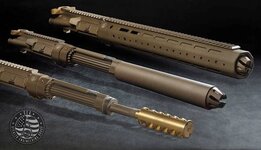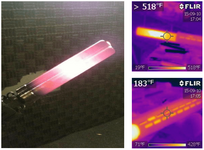- Messages
- 211
- Reactions
- 353
The Naval Special Warfare Center – Crane is developing an M4 that has integral suppression for both sound and thermal signature! They're calling it Suppressed Upper Receiver Group (SURG). I just heard about this today, it's very cool, and the engineering geek in me is excited and wants to share.
Apparently, bad guys are learning to locate our soldiers via the thermal signature of their rifles, using either looted or black market thermal imagers, or modified civilian still/video cameras with the CCD/CMOS sensor's IR filter removed.
The problem is complex:
All the heat generated has to go somewhere – you can't make it just magically disappear (conservation of energy and all).
Protect the user and attached accessories from 500° - 1,000° heat that's less than an inch away, inside the fore end.
Incorporate a sound suppressor.
Create no muzzle flash.
Produce 2,600fps velocity, 3" groups at 100 yards, and last 15,000 rounds. This is both a design and materials problem, as the SURG will be subject to much higher thermal stresses than a standard M4 upper.
My understanding of the solution is that it's simple in concept, but challenging in practice:
Heat from the barrel, silencer and muzzle device is contained within an insulated sleeve. It sounds like they're going with Insulon, which is the same idea as the old vacuum-insulated Thermos, but made of metal sheets instead of glass. The vacuum space can be very small – in this case only about 1 millimeter across – and still be extremely effective. This vacuum space halts conductive and convective cooling, meaning little to no heat signature, and both the user and fore end-mounted accessories are protected.
So where does that heat go? This the neat part: with any gun, some of the muzzle blast travels backwards towards the user (this is what you wear ear pro for – duh). The SURG design uses this blast like a fan to push cool air into the muzzle end of the Insulon sleeve, along the barrel and over the barrel nut (which doubles as a finned heat sink), and then diffuses the now-hot air into the surrounding air, cooling it enough to reduce the thermal signature. If it helps, this is the same idea behind engine outlets of the B2 bomber or A-10 Warthog, where the outlets are recessed (B2) or hidden (A-10) behind part of the airframe, which blocks direct view from below of the hot outlet gasses, and allowing the exhaust to mix with surrounding air and cool a bit before it's visible to a heat-seeking SAM below.
The sound suppressor is also crazy innovative: It's a reflex design, meaning it extends back along the barrel, nested between the barrel and the Insulon sleeve. The barrel is ported in several places along its length, diverting a pre-determined amount of gas into the suppressor, like the old MP5N did. Towards the end of the barrel is a baffle stack, sort of like a standard suppressor, except for two oddities mentioned in the patent: the use of elastic materials in the baffles – the hot gas would transfer its energy and heat by stretching this material; and the use of movable baffles – similarly, moving the baffles would transfer energy away from the gas.
Finally, the SURG will accept any standard flash hider or brake. Presumably, you could attach another suppressor, because, like Xzibit says, I heard you like suppressors, so I put a suppressor on your suppressor so you can suppress while you're suppressing (Hmm, maybe the wrong crowd for that reference).
(Hmm, maybe the wrong crowd for that reference).
I have no formal training as an engineer or physicist, but I do understand a bit of the engineering and physics concepts underpinning how this works. So, I'll try to answer any questions that I can, and I'll say "I don't know" when I don't.
In case there's concern about op-sec / info-sec, all of this is publicly available in the patent and two non-classified presentations, linked below.
The two presentations with lots of cool photos:
<broken link removed>
<broken link removed>
The patent:
Patent Images (Patent Images (Patent Images (http://pdfpiw.uspto.gov/.piw?PageNum=0&docid=09273920&IDKey=C068DF5B6B64&HomeUrl=http%3A%2F%2Fpatft.uspto.gov%2Fnetacgi%2Fnph-Parser%3FSect1%3DPTO1%2526Sect2%3DHITOFF%2526d%3DPALL%2526p%3D1%2526u%3D%25252Fnetahtml%25252FPTO%25252Fsrchnum.htm%2526r%3D1%2526f%3DG%2526l%3D50%2526s1%3D9%2C273%2C920.PN.%2526OS%3DPN%2F9%2C273%2C920%2526RS%3DPN%2F9%2C273%2C920)))
– Vorpalis
Apparently, bad guys are learning to locate our soldiers via the thermal signature of their rifles, using either looted or black market thermal imagers, or modified civilian still/video cameras with the CCD/CMOS sensor's IR filter removed.
The problem is complex:
All the heat generated has to go somewhere – you can't make it just magically disappear (conservation of energy and all).
Protect the user and attached accessories from 500° - 1,000° heat that's less than an inch away, inside the fore end.
Incorporate a sound suppressor.
Create no muzzle flash.
Produce 2,600fps velocity, 3" groups at 100 yards, and last 15,000 rounds. This is both a design and materials problem, as the SURG will be subject to much higher thermal stresses than a standard M4 upper.
My understanding of the solution is that it's simple in concept, but challenging in practice:
Heat from the barrel, silencer and muzzle device is contained within an insulated sleeve. It sounds like they're going with Insulon, which is the same idea as the old vacuum-insulated Thermos, but made of metal sheets instead of glass. The vacuum space can be very small – in this case only about 1 millimeter across – and still be extremely effective. This vacuum space halts conductive and convective cooling, meaning little to no heat signature, and both the user and fore end-mounted accessories are protected.
So where does that heat go? This the neat part: with any gun, some of the muzzle blast travels backwards towards the user (this is what you wear ear pro for – duh). The SURG design uses this blast like a fan to push cool air into the muzzle end of the Insulon sleeve, along the barrel and over the barrel nut (which doubles as a finned heat sink), and then diffuses the now-hot air into the surrounding air, cooling it enough to reduce the thermal signature. If it helps, this is the same idea behind engine outlets of the B2 bomber or A-10 Warthog, where the outlets are recessed (B2) or hidden (A-10) behind part of the airframe, which blocks direct view from below of the hot outlet gasses, and allowing the exhaust to mix with surrounding air and cool a bit before it's visible to a heat-seeking SAM below.
The sound suppressor is also crazy innovative: It's a reflex design, meaning it extends back along the barrel, nested between the barrel and the Insulon sleeve. The barrel is ported in several places along its length, diverting a pre-determined amount of gas into the suppressor, like the old MP5N did. Towards the end of the barrel is a baffle stack, sort of like a standard suppressor, except for two oddities mentioned in the patent: the use of elastic materials in the baffles – the hot gas would transfer its energy and heat by stretching this material; and the use of movable baffles – similarly, moving the baffles would transfer energy away from the gas.
Finally, the SURG will accept any standard flash hider or brake. Presumably, you could attach another suppressor, because, like Xzibit says, I heard you like suppressors, so I put a suppressor on your suppressor so you can suppress while you're suppressing
I have no formal training as an engineer or physicist, but I do understand a bit of the engineering and physics concepts underpinning how this works. So, I'll try to answer any questions that I can, and I'll say "I don't know" when I don't.
In case there's concern about op-sec / info-sec, all of this is publicly available in the patent and two non-classified presentations, linked below.
The two presentations with lots of cool photos:
<broken link removed>
<broken link removed>
The patent:
Patent Images (Patent Images (Patent Images (http://pdfpiw.uspto.gov/.piw?PageNum=0&docid=09273920&IDKey=C068DF5B6B64&HomeUrl=http%3A%2F%2Fpatft.uspto.gov%2Fnetacgi%2Fnph-Parser%3FSect1%3DPTO1%2526Sect2%3DHITOFF%2526d%3DPALL%2526p%3D1%2526u%3D%25252Fnetahtml%25252FPTO%25252Fsrchnum.htm%2526r%3D1%2526f%3DG%2526l%3D50%2526s1%3D9%2C273%2C920.PN.%2526OS%3DPN%2F9%2C273%2C920%2526RS%3DPN%2F9%2C273%2C920)))
– Vorpalis
Last Edited:













